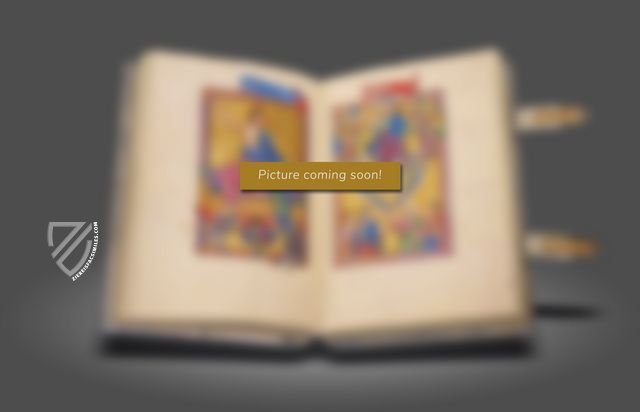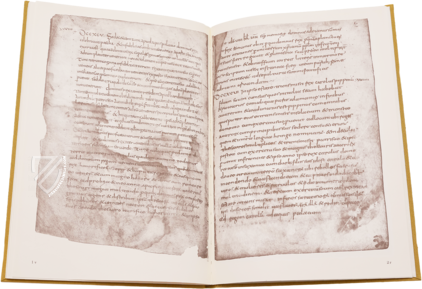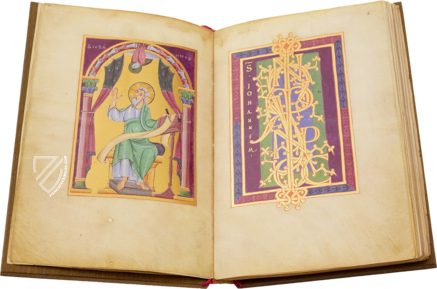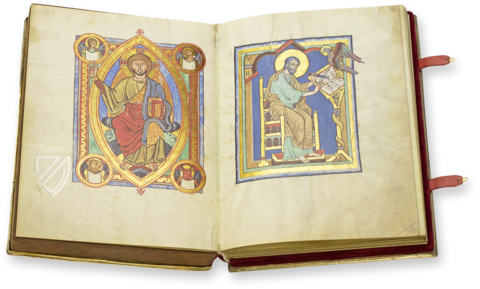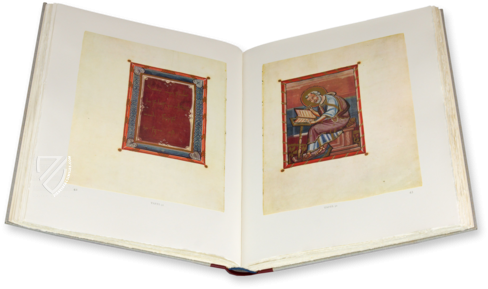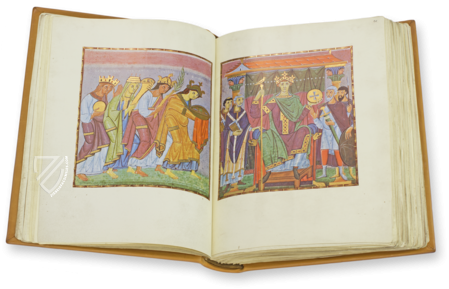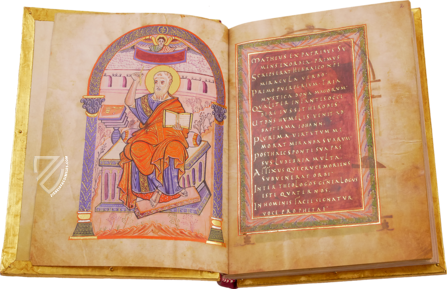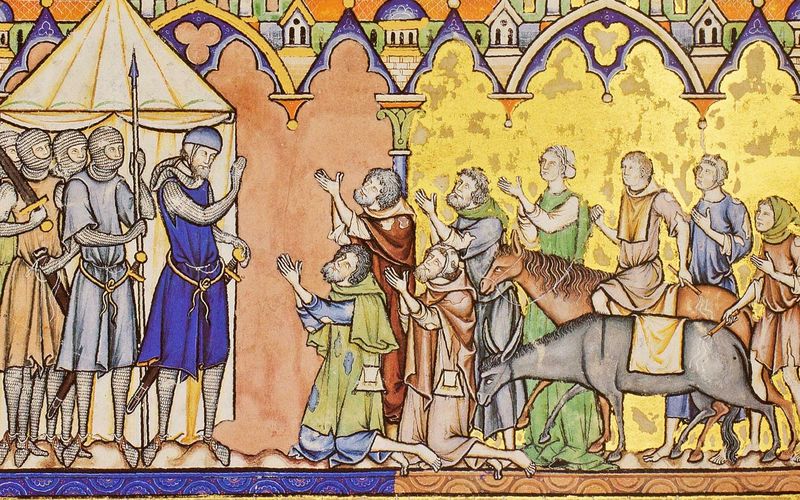Strahov Evangeliary
(7,000€ - 10,000€)
A primary work of Ottonian illumination that has served as a template for successive masterpieces of medieval book art: the Strahov Evangeliary. Originating from the famous Tours scriptorium in the 9th century, the famous Gospel book was further illuminated in Trier’s church of St. Martin during the 10th century by the famous Master of Registrum Gregorii. This manuscript is famous above all for its iconic Evangelist portraits, which were emulated in numerous successive manuscripts. The rich use of gold leaf is further highlighted by sumptuous backgrounds of purple, green, and vermilion.
Strahov Evangeliary
The Strahov Evangeliary is counted among the primary works of Ottonian book illumination. The manuscript is stored under the shelf mark Ms. DF III 3 in Prague’s Strahov Monastery. It is significant for its illumination, which originated from the so-called Master of Registrum Gregorii or Gregory Master, who was active in Trier. The uncial text and some of the décor of the manuscript appears to originate from the famous Tours scriptorium ca. 860 before it was brought to the Church of St. Martin in Trier where it was further adorned ca. 980. The manuscript measures 26.7 × 16.9 cm and contains 222 sheets of parchment. It is bound in a 15th-century red velvet cover, to which older parts have been applied, such as cast, gilt figures. On fol. 2r is the ownership note of the Abbey of St. Martin reads si quis eum abstulerit, anathematisatus sit “if anyone should steal the book then the Anathema should meet him”. The Gregory Master, who worked for Egbert (ca. 950–993), Archbishop of Trier, revised the manuscript, partly shedding the existing script. He added Evangelist portraits, gilded initials, chapter numbers, and holy names, and put on purple pages, some of them written in gold, while also using vermilion and green backgrounds. This fine manuscript inspired future generations of illuminators.
Style-Setting Evangelist Portraits
The most important addition made by the Gregory Master was the four Evangelist portraits on purple grounds (folios 8v, 69v, 107v, 176v). These images are all divided by a horizontal stripe with an explanatory inscription, so that Evangelist and their symbol are in two separate fields. For example, John is shown from the front and seated on a cushioned box throne with a massive writing desk, on top of which are two rolled-up scrolls and an inkwell with a pen in it. Unlike the other Evangelists, John presents his Gospel in the form of a bound codex in the left hand, the beginning of the text being legible in shorthand. In his right hand, John holds a quill. In the crossbeam between John and his symbol it reads: EST AQUILA ALTA PETENS NARRANS DIUINA IOHANNES, “John is an eagle who aspires to heaven and reports heavenly things”. For the Strahov Evangeliary, the Gregory Master developed a new representational form by adding the Evangelist symbols and the inscriptions. The plasticity of the figures reveals the influence of Late Antique role models, while the animal figures display "natural liveliness" according to Hartmut Hoffmann.
A New Generation of Evangeliaries
The Evangelist images of the Sainte-Chapelle Gospels, another highpoint of Ottonian Illumination created by the Gregory Master, are closest to the Strahov Evangeliary, especially the symbols. Works inspired by him include a single sheet with Mark the Evangelist found in the Preaching Seminary of St. Peter in the Black Forest, which exactly follows the image type of Mark found here. It is disputed whether the sheet is attributed a pupil or to the Gregory Master himself. The image structure is simplified in the Gospel of St. Maximin, shelf mark Ms. theol. lat. fol. 283 of the Berlin State Library. In both manuscripts, a long rectangular field is divided sharply between the Evangelist and his symbol. The attitude of his Evangelists suggests that the painter of the Berlin manuscript was a student of the Gregory Master. A manuscript in the Biblioteca Medicea Laurenziana in Florence (Acq e Doni 91) also appears to have this influence. Written in Italy in the 12th century, it has four evangelist pictures and a picture of the Ascension, which clearly draw on German models. With all of this in mind, the Gregory Master is undoubtedly one of the most influential artists of the Early Middle Ages.
A Czech Velvet Binding
Today the manuscript is protected by a richly adorned red velvet binding originating from ca. 1500, the work of a Czech bookbinder. The front cover is filled with various figures such as a silver crucifix, four gilded figures of the Virgin Mary, St. John the Evangelist, and two saint bishops. Four silver medallions present the Evangelists. Two gilded metal bands are found at the top and bottom of the cover, each with two enameled discs from the Romanesque period. The enamels frame gilded figures of Christ Benedictory at the top with Madonna and Child at the bottom. Cut crystals and semi-precious stones round out the luxury binding, which is protected by silver fittings at the corners (both front and back) and held shut with two gilded clasps.
Codicology
- Alternative Titles
- Evangeliarum Strahoviense
- Size / Format
- 444 pages / 27.0 × 16.8 cm
- Origin
- France
- Date
- 860–980
- Epochs
- Style
- Genre
- Language
- Script
- Roman uncial
- Illustrations
- 4 full-page portraits of the Evangelists; 4 full-page purple-dyed Incipit pages
- Content
- Evangeliary
- Artist / School
- Gregory Master (illuminator)
Trier School
#1 Evangelistarium Strahoviense
(7,000€ - 10,000€)
- Treatises / Secular Books
- Apocalypses / Beatus
- Astronomy / Astrology
- Bestiaries
- Bibles / Gospels
- Chronicles / History / Law
- Geography / Maps
- Saints' Lives
- Islam / Oriental
- Judaism / Hebrew
- Single Leaf Collections
- Leonardo da Vinci
- Literature / Poetry
- Liturgical Manuscripts
- Medicine / Botany / Alchemy
- Music
- Mythology / Prophecies
- Psalters
- Other Religious Books
- Games / Hunting
- Private Devotion Books
- Other Genres
- Afghanistan
- Armenia
- Austria
- Belgium
- Belize
- Bosnia and Herzegovina
- China
- Colombia
- Costa Rica
- Croatia
- Cyprus
- Czech Republic
- Denmark
- Egypt
- El Salvador
- Ethiopia
- France
- Germany
- Greece
- Guatemala
- Honduras
- Hungary
- India
- Iran
- Iraq
- Israel
- Italy
- Japan
- Jordan
- Kazakhstan
- Kyrgyzstan
- Lebanon
- Liechtenstein
- Luxembourg
- Mexico
- Morocco
- Netherlands
- Palestine
- Panama
- Peru
- Poland
- Portugal
- Romania
- Russia
- Serbia
- Spain
- Sri Lanka
- Sweden
- Switzerland
- Syria
- Tajikistan
- Turkey
- Turkmenistan
- Ukraine
- United Kingdom
- United States
- Uzbekistan
- Vatican City
- A. Oosthoek, van Holkema & Warendorf
- Aboca Museum
- Ajuntament de Valencia
- Akademie Verlag
- Akademische Druck- u. Verlagsanstalt (ADEVA)
- Aldo Ausilio Editore - Bottega d’Erasmo
- Alecto Historical Editions
- Alkuin Verlag
- Almqvist & Wiksell
- Amilcare Pizzi
- Andreas & Andreas Verlagsbuchhandlung
- Archa 90
- Archiv Verlag
- Archivi Edizioni
- Arnold Verlag
- ARS
- Ars Magna
- ArtCodex
- AyN Ediciones
- Azimuth Editions
- Badenia Verlag
- Bärenreiter-Verlag
- Belser Verlag
- Belser Verlag / WK Wertkontor
- Benziger Verlag
- Bernardinum Wydawnictwo
- BiblioGemma
- Biblioteca Apostolica Vaticana (Vaticanstadt, Vaticanstadt)
- Bibliotheca Palatina Faksimile Verlag
- Bibliotheca Rara
- Boydell & Brewer
- Bramante Edizioni
- Bredius Genootschap
- Brepols Publishers
- British Library
- C. Weckesser
- Caixa Catalunya
- Canesi
- CAPSA, Ars Scriptoria
- Caratzas Brothers, Publishers
- Carus Verlag
- Casamassima Libri
- Centrum Cartographie Verlag GmbH
- Chavane Verlag
- Christian Brandstätter Verlag
- Circulo Cientifico
- Club Bibliófilo Versol
- Club du Livre
- CM Editores
- Collegium Graphicum
- Collezione Apocrifa Da Vinci
- Comissão Nacional para as Comemorações dos Descobrimentos Portugueses
- Coron Verlag
- Corvina
- CTHS
- D. S. Brewer
- Damon
- De Agostini/UTET
- De Nederlandsche Boekhandel
- De Schutter
- Deuschle & Stemmle
- Deutscher Verlag für Kunstwissenschaft
- DIAMM
- Droz
- E. Schreiber Graphische Kunstanstalten
- Ediciones Boreal
- Ediciones Grial
- Ediclube
- Edições Inapa
- Edilan
- Editalia
- Edition Deuschle
- Edition Georg Popp
- Edition Leipzig
- Edition Libri Illustri
- Editiones Reales Sitios S. L.
- Éditions de l'Oiseau Lyre
- Editions Medicina Rara
- Editorial Casariego
- Editorial Mintzoa
- Editrice Antenore
- Editrice Velar
- Edizioni Edison
- Egeria, S.L.
- Eikon Editores
- Electa
- Emery Walker Limited
- Enciclopèdia Catalana
- Eos-Verlag
- Ephesus Publishing
- Ernst Battenberg
- Eugrammia Press
- Extraordinary Editions
- Fackelverlag
- Facsimila Art & Edition
- Facsimile Editions Ltd.
- Facsimilia Art & Edition Ebert KG
- Faksimile Verlag
- Feuermann Verlag
- Folger Shakespeare Library
- Franco Cosimo Panini Editore
- Friedrich Wittig Verlag
- Fundación Hullera Vasco-Leonesa
- G. Braziller
- Gabriele Mazzotta Editore
- Gebr. Mann Verlag
- Gesellschaft für graphische Industrie
- Getty Research Institute
- Giovanni Domenico de Rossi
- Giunti Editore
- Graffiti
- Grafica European Center of Fine Arts
- Guido Pressler
- Guillermo Blazquez
- Gustav Kiepenheuer
- H. N. Abrams
- Harrassowitz
- Harvard University Press
- Helikon
- Hendrickson Publishers
- Henning Oppermann
- Herder Verlag
- Hes & De Graaf Publishers
- Hoepli
- Holbein-Verlag
- Houghton Library
- Hugo Schmidt Verlag
- Idion Verlag
- Il Bulino, edizioni d'arte
- ILte
- Imago
- Insel Verlag
- Insel-Verlag Anton Kippenberger
- Instituto de Estudios Altoaragoneses
- Instituto Nacional de Antropología e Historia
- Introligatornia Budnik Jerzy
- Istituto dell'Enciclopedia Italiana - Treccani
- Istituto Ellenico di Studi Bizantini e Postbizantini
- Istituto Geografico De Agostini
- Istituto Poligrafico e Zecca dello Stato
- Italarte Art Establishments
- Jan Thorbecke Verlag
- Johnson Reprint Corporation
- Josef Stocker
- Josef Stocker-Schmid
- Jugoslavija
- Karl W. Hiersemann
- Kasper Straube
- Kaydeda Ediciones
- Kindler Verlag / Coron Verlag
- Kodansha International Ltd.
- Konrad Kölbl Verlag
- Kurt Wolff Verlag
- La Liberia dello Stato
- La Linea Editrice
- La Meta Editore
- Lambert Schneider
- Landeskreditbank Baden-Württemberg
- Leo S. Olschki
- Les Incunables
- Liber Artis
- Library of Congress
- Libreria Musicale Italiana
- Lichtdruck
- Lito Immagine Editore
- Lumen Artis
- Lund Humphries
- M. Moleiro Editor
- Maison des Sciences de l'homme et de la société de Poitiers
- Manuscriptum
- Martinus Nijhoff
- Maruzen-Yushodo Co. Ltd.
- MASA
- Massada Publishers
- McGraw-Hill
- Metropolitan Museum of Art
- Militos
- Millennium Liber
- Müller & Schindler
- Nahar - Stavit
- Nahar and Steimatzky
- National Library of Wales
- Neri Pozza
- Nova Charta
- Oceanum Verlag
- Odeon
- Orbis Mediaevalis
- Orbis Pictus
- Österreichische Staatsdruckerei
- Oxford University Press
- Pageant Books
- Parzellers Buchverlag
- Patrimonio Ediciones
- Pattloch Verlag
- PIAF
- Pieper Verlag
- Plon-Nourrit et cie
- Poligrafiche Bolis
- Presses Universitaires de Strasbourg
- Prestel Verlag
- Princeton University Press
- Prisma Verlag
- Priuli & Verlucca, editori
- Pro Sport Verlag
- Propyläen Verlag
- Pytheas Books
- Quaternio Verlag Luzern
- Reales Sitios
- Recht-Verlag
- Reichert Verlag
- Reichsdruckerei
- Reprint Verlag
- Riehn & Reusch
- Roberto Vattori Editore
- Rosenkilde and Bagger
- Roxburghe Club
- Salerno Editrice
- Saltellus Press
- Sandoz
- Sarajevo Svjetlost
- Schöck ArtPrint Kft.
- Schulsinger Brothers
- Scolar Press
- Scrinium
- Scripta Maneant
- Scriptorium
- Shazar
- Siloé, arte y bibliofilia
- SISMEL - Edizioni del Galluzzo
- Sociedad Mexicana de Antropología
- Société des Bibliophiles & Iconophiles de Belgique
- Soncin Publishing
- Sorli Ediciones
- Stainer and Bell
- Studer
- Styria Verlag
- Sumptibus Pragopress
- Szegedi Tudomànyegyetem
- Taberna Libraria
- Tarshish Books
- Taschen
- Tempus Libri
- Testimonio Compañía Editorial
- Thames and Hudson
- The Clear Vue Publishing Partnership Limited
- The Facsimile Codex
- The Folio Society
- The Marquess of Normanby
- The Richard III and Yorkist History Trust
- Tip.Le.Co
- TouchArt
- TREC Publishing House
- TRI Publishing Co.
- Trident Editore
- Tuliba Collection
- Typis Regiae Officinae Polygraphicae
- Union Verlag Berlin
- Universidad de Granada
- University of California Press
- University of Chicago Press
- Urs Graf
- Vallecchi
- Van Wijnen
- VCH, Acta Humaniora
- VDI Verlag
- VEB Deutscher Verlag für Musik
- Verlag Anton Pustet / Andreas Verlag
- Verlag Bibliophile Drucke Josef Stocker
- Verlag der Münchner Drucke
- Verlag für Regionalgeschichte
- Verlag Styria
- Vicent Garcia Editores
- W. Turnowski Ltd.
- W. Turnowsky
- Waanders Printers
- Wiener Mechitharisten-Congregation (Wien, Österreich)
- Wissenschaftliche Buchgesellschaft
- Wissenschaftliche Verlagsgesellschaft
- Wydawnictwo Dolnoslaskie
- Xuntanza Editorial
- Zakład Narodowy
- Zollikofer AG

